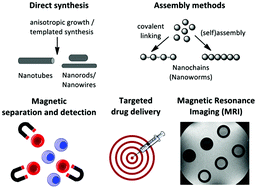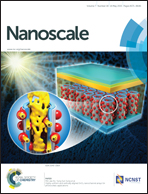Shape matters: synthesis and biomedical applications of high aspect ratio magnetic nanomaterials
Abstract
High aspect ratio magnetic nanomaterials possess anisotropic properties that make them attractive for biological applications. Their elongated shape enables multivalent interactions with receptors through the introduction of multiple targeting units on their surface, thus enhancing cell internalization. Moreover, due to their magnetic anisotropy, high aspect ratio nanomaterials can outperform their spherical analogues as contrast agents for magnetic resonance imaging (MRI) applications. In this review, we first describe the two main synthetic routes for the preparation of anisotropic magnetic nanomaterials: (i) direct synthesis (in which the anisotropic growth is directed by tuning the reaction conditions or by using templates) and (ii) assembly methods (in which the high aspect ratio is achieved by assembly from individual building blocks). We then provide an overview of the biomedical applications of anisotropic magnetic nanomaterials: magnetic separation and detection, targeted delivery and magnetic resonance imaging.



 Please wait while we load your content...
Please wait while we load your content...